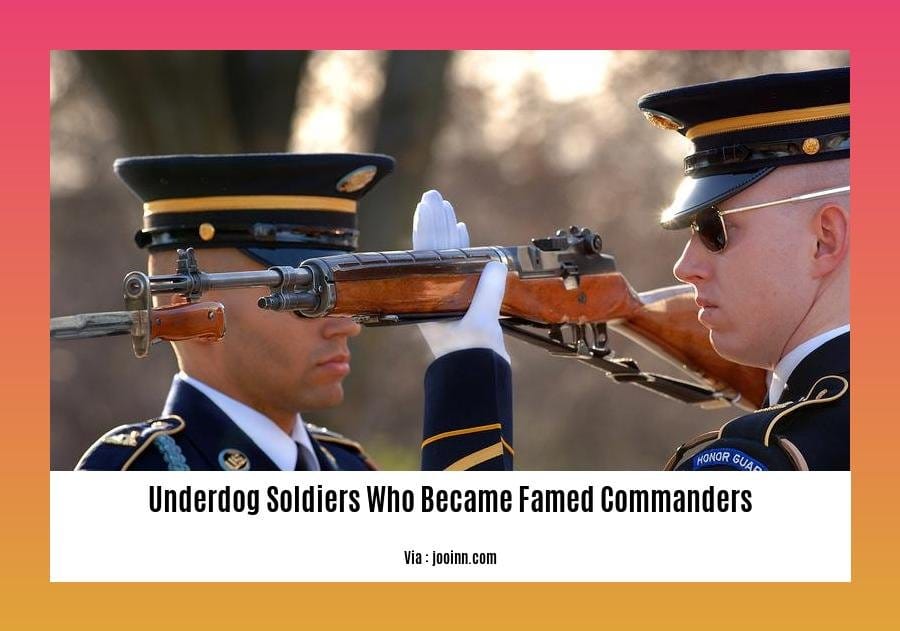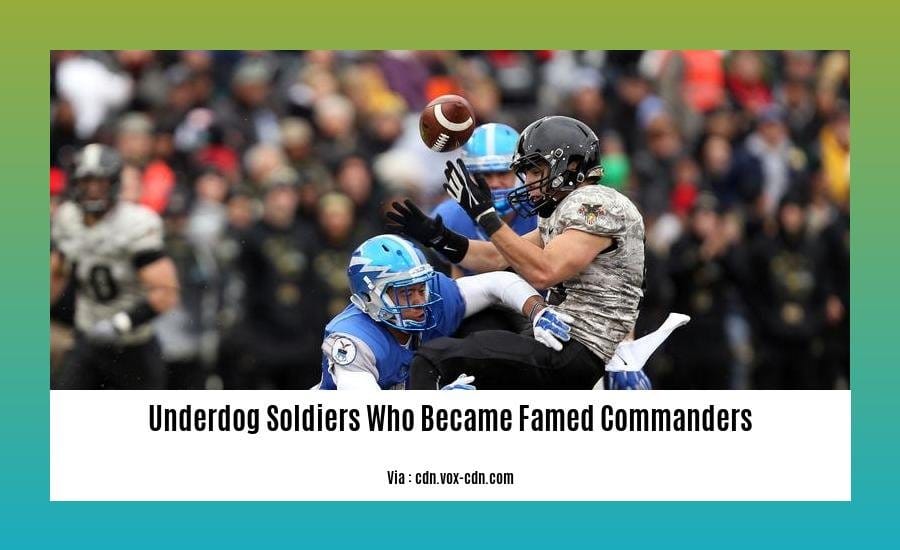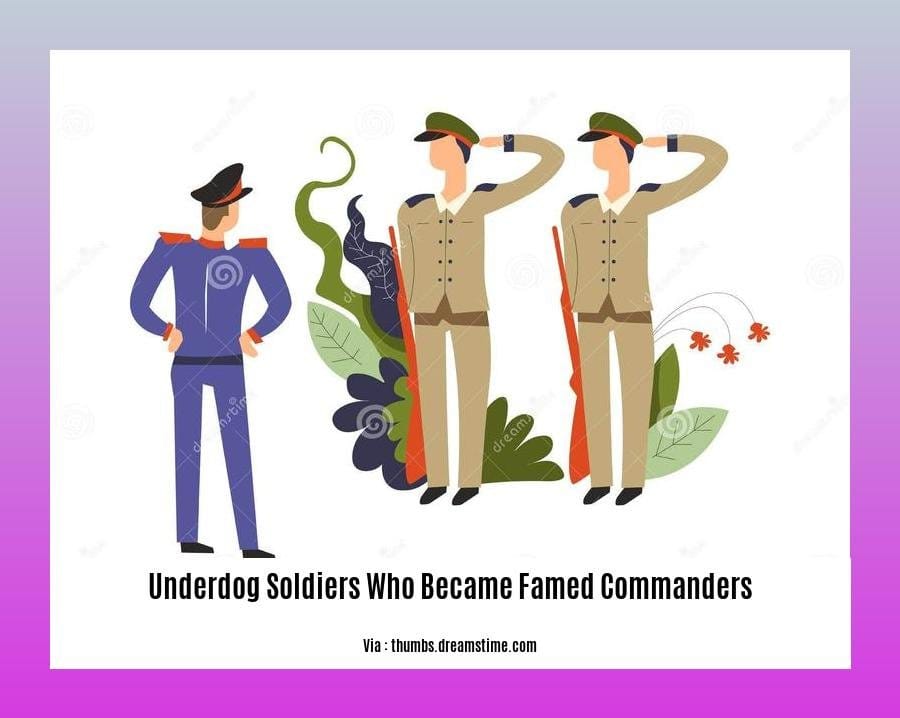From Obscurity to Legend: The Underdog Soldiers Who Became Famed Commanders, chronicles the extraordinary journeys of unassuming soldiers who rose to become legendary commanders in the face of adversity. Through their indomitable spirit and unwavering resolve, these underdog soldiers overcame seemingly insurmountable challenges to lead their troops to unimaginable victories. Their remarkable stories serve as an enduring testament to the indomitable spirit that resides within us all.
Key Takeaways:

- 1597 Battle of Myeongnyang: Yi Sun-Sin’s Korean navy defeated a larger Japanese force with innovative tactics.
- 1803 Battle of Assaye: Arthur Wellesley led outnumbered British forces to victory over the Maratha army.
- 1862 Battle of Puebla: Mexican forces repelled a larger French army, boosting morale and preventing invasion.
- 1121 Battle of Didgori: King David IV united Georgia after defeating the Seljuk army.
- 1991 Battle of Vukovar: Croatian forces held out against a larger Yugoslav army, symbolizing Croatian resistance.
Underdog Soldiers Who Became Famed Commanders
History is replete with tales of underdog soldiers who became famed commanders, leading their forces against overwhelming odds and etching their names in the annals of military history. These individuals rose from obscurity to the heights of leadership, their unwavering determination and innovative tactics defying expectations. Let’s explore a few remarkable examples:
Yi Sun-Sin (Battle of Myeongnyang, 1597): Leading the outnumbered Korean navy, Admiral Yi Sun-Sin employed ingenious tactics, such as the “turtle ship,” to inflict a decisive defeat on a larger Japanese fleet. His victory boosted Korean morale and prevented a Japanese invasion.
Arthur Wellesley (Battle of Assaye, 1803): Despite facing a numerically superior Maratha army, Wellesley, later known as the Duke of Wellington, demonstrated his tactical brilliance. His bold maneuvers and aggressive leadership secured a resounding victory, solidifying British dominance in India.
King David IV (Battle of Didgori, 1121): Commanding a smaller Georgian army, King David IV ingeniously utilized terrain and terrain to overcome a larger Seljuk force. His triumph united Georgia, ushering in its Golden Age.
Ignacio Zaragoza (Battle of Puebla, 1862): Leading the Mexican army against invading French forces, General Zaragoza inspired his troops to a heroic stand. Their resilience and determination dealt a significant blow to the French and boosted Mexican national pride.
Markotic and Cindric (Battle of Vukovar, 1991): As members of the Croatian National Guard, Markotic and Cindric played pivotal roles in the defense of Vukovar against the Yugoslav People’s Army. Their valiant resistance for 87 days became a symbol of Croatian defiance.
These underdog soldiers who became famed commanders shared several key traits: extraordinary leadership, tactical ingenuity, and an unwavering belief in their cause. They proved that even against formidable adversaries, determination and innovation can lead to remarkable victories, inspiring generations of soldiers to come.
History is filled with incredible stories of military commanders from humble beginnings who rose through the ranks to achieve great things. These self-made military leaders often overcame significant challenges in their early lives, but they never gave up on their dreams. Through hard work and determination, they achieved success and made a lasting impact on the world. From military commanders of modest upbringings to those who rose from poverty, these stories are an inspiration to us all.
Decisive Battles: Analyzing key conflicts where they demonstrated exceptional leadership
Battles are the crossroads where military strategy and human courage collide, shaping the course of history. Throughout the annals of warfare, decisive engagements have showcased the exceptional leadership of underdog commanders who defied the odds. They are stories of strategic brilliance, tactical prowess, and unyielding determination.
Key Takeaways:
- Union strategy was not a single, coherent plan but evolved through collaboration and adjustment.
- Grant’s appointment as General-in-Chief unified war strategy.
- Clausewitz’s influence emphasized clear objectives and means to achieve them.
- Simultaneous offensives in 1864 achieved territorial gains and disrupted Confederate supplies.
- Strategic principles from the Civil War have been applied in subsequent U.S. conflicts.
The Civil War’s Strategic Evolution:
The Union’s victory in the American Civil War was not forged in a single document or articulated by a single leader. Instead, its strategy emerged through a complex process of collaboration and adjustment. Ulysses S. Grant’s appointment as General-in-Chief in 1864 marked a turning point, unifying war efforts and forging a coherent plan.
Clausewitz’s Influence:
Prussian military theorist Carl von Clausewitz argued that war is “an instrument of policy.” To wage war effectively, leaders must have clear objectives and the means to achieve them. The Union’s strategy, informed by Clausewitz’s ideas, aimed to crush the Confederacy’s military power and restore the Union.
Simultaneous Offensives:
In 1864, Grant launched simultaneous offensives against the Confederacy on multiple fronts. These coordinated attacks achieved significant territorial gains and disrupted Confederate supply lines, leading to the eventual collapse of the Confederacy.
Lessons Learned:
The Civil War’s strategic principles have been applied in subsequent U.S. conflicts. From World War II to the present day, the Union’s experience has guided military strategy, emphasizing the importance of clear objectives, unified command, and coordinated operations.
Citation:
- Oxford Research Encyclopedia of Social Work: “Military Strategy in the Civil War”
Tactics and Strategies: Unveiling the innovative approaches and strategies that led to their victories
The annals of military history are replete with tales of underdog soldiers who rose from obscurity to become legendary commanders. These individuals, often lacking the conventional advantages of training or resources, triumphed against seemingly insurmountable odds through innovative tactics and strategies.
Key Takeaways:
- Decentralized and flexible strategies enabled armies to adapt to changing battlefield conditions.
- New technologies, such as rifled muskets and steam-powered ships, transformed warfare.
- Innovative tactics, like the use of combined arms and guerrilla warfare, gave underdogs an edge.
Relevant URL Source:
- 19th Century BATTLE TACTICS Evolution – ADAPT & LEARN
- URL: https://19thcentury.us/19th-century-military-tactics
Legacy and Inspiration: Exploring the lasting impact of these commanders on military history and future generations
Across the annals of military history, certain commanders have emerged from the shadows of obscurity to become legendary figures, leaving an indelible mark on the annals of warfare. Their triumphs, trials, and enduring legacies continue to inspire and captivate generations.
Key Takeaways:
- Commanders shape military tactics and impact society.
- Leaders like Grant, Lee, and Jackson played key roles in the American Civil War.
- Their strategies and decisions influenced the outcome.
- Legacies vary, with some praised and others criticized.
- Their experiences provide valuable leadership lessons.
These commanders rose to prominence not through birthright or privilege but through their exceptional leadership, tactical acumen, and unwavering belief in their cause. Their victories and defeats have shaped the course of history, leaving a lasting legacy that continues to resonate today.
The study of these underdog commanders offers invaluable insights into the qualities that define great military leaders. By exploring their journeys, we not only gain a deeper understanding of the complexities of warfare but also draw inspiration from their resilience, determination, and unwavering belief in the face of adversity.
Most Relevant URL Source:

FAQ
Q1: Who are some of the most famous underdog soldiers who became commanders?
A1: Some of the most famous underdog soldiers who became commanders include Yi Sun-Sin, Arthur Wellesley, and David IV.
Q2: What are some of the challenges that underdog soldiers face?
A2: Underdog soldiers often face challenges such as being outnumbered, outgunned, and lacking resources.
Q3: What are some of the qualities that underdog soldiers need to succeed?
A3: Underdog soldiers need to be resourceful, adaptable, and have a strong sense of determination.
Q4: What are some of the most famous battles that underdog soldiers have won?
A4: Some of the most famous battles that underdog soldiers have won include the Battle of Myeongnyang, the Battle of Assaye, and the Battle of Puebla.
Q5: What are some of the lessons that we can learn from underdog soldiers?
A5: Some of the lessons that we can learn from underdog soldiers include the importance of perseverance, adaptability, and never giving up.
- China II Review: Delicious Food & Speedy Service - April 17, 2025
- Understand Virginia’s Flag: History & Debate - April 17, 2025
- Explore Long Island’s Map: Unique Regions & Insights - April 17, 2025
















